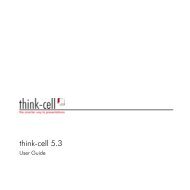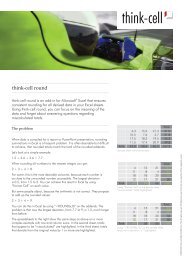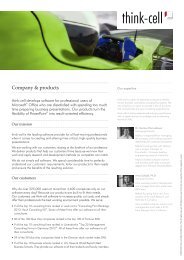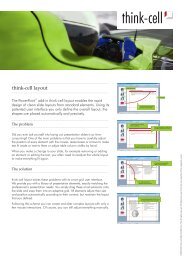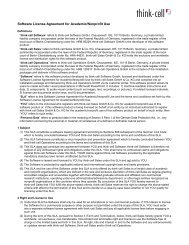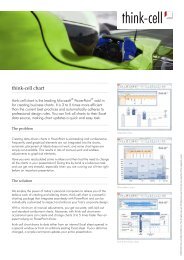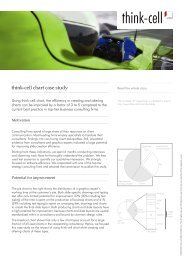think-cell technical report TC2003/01 A GUI-based Interaction ...
think-cell technical report TC2003/01 A GUI-based Interaction ...
think-cell technical report TC2003/01 A GUI-based Interaction ...
You also want an ePaper? Increase the reach of your titles
YUMPU automatically turns print PDFs into web optimized ePapers that Google loves.
4.1 A New Approach to Slide Layout INTERACTION CONCEPT<br />
User interaction<br />
User interaction<br />
User <strong>think</strong>-<strong>cell</strong> add-in<br />
Micosoft PowerPoint<br />
Figure 10: The user’s view: The <strong>think</strong>-<strong>cell</strong> add-in helps to quickly generate satisfying<br />
results in Microsoft PowerPoint. Besides the specific UI widgets, all PowerPoint<br />
features behave as usual.<br />
With these observations in mind, the extension of PowerPoint with some auto-<br />
mated layout optimization technique appears promising. The user should be able<br />
to specify intentions, which are recognized by the program as numeric constraints.<br />
Constraints can be solved and the intended layout can be arranged by the computer.<br />
Moreover, when part of the composition is changed by the user, the over-all layout<br />
can be updated to preserve the constraints that were specified earlier.<br />
The <strong>think</strong>-<strong>cell</strong> layout add-in for Microsoft PowerPoint provides these features.<br />
From the user’s point of view, the <strong>think</strong>-<strong>cell</strong> software adds some new UI widgets<br />
to the Microsoft PowerPoint user interface (Fig. 10), while the rest of PowerPoint<br />
looks and behaves just the way it always did.<br />
The challenge of this approach is to model the characteristics of optimal layout in<br />
a way that can be computationally solved. This leads to the idea of a “smart grid”:<br />
Constraints that can be expressed by a grid-like structure are almost sufficient to<br />
describe a layout model for business slides.<br />
4.1.2 The Smart Grid Concept<br />
The smart grid concept provides an abstraction from exact pixel positions and<br />
absolute sizes. The additional abstraction layer simplifies user input, requiring<br />
greater machine work to interpret the input and to translate the user’s incomplete<br />
layout specification into a fully specified slide layout. The gap between the abstract,<br />
incomplete layout specification and the final layout is bridged by generic constraints<br />
that formalize design rules for esthetic layout.<br />
Figure 11 provides an overview of the automation process. This work focuses<br />
on the user interaction, whereas the solving of numeric constraints that is required<br />
to implement a self-adjusting smart grid is beyond the scope of my thesis.<br />
Terminology<br />
The smart grid is a dual concept <strong>based</strong> on smart gridlines and smart elements.<br />
Figure 12 visualizes how the components of the concept interact. Smart elements<br />
are bound to horizontal and vertical gridlines; elements that are bound to the same<br />
gridline are effectively aligned.<br />
35



